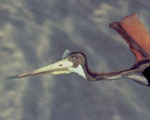 |
 |
Introduction Teachers Guide
Insects Birds Bats Pterosaurs Fish Wing Structures
Gliding Soaring Flapping Migration
Seed Helicopter Build a Bird
Ornithopter Zone Web Site Links |
Pterosaurs
There were two major groups. Rhamphorynch pterosaurs, with teeth and long tails, dominated skies of the Jurassic period. They gave rise to pterodactyls, which had short tails and, in many cases, toothless beaks. Quetzalcoatlus northropi was the largest known pterosaur. Its wings spanned perhaps 11 meters, and it weighed about 65 kilograms. Pterosaurs had a wide range of feeding adaptations and held similar niches to the birds of today. Competition with birds may have contributed to their late-Cretaceous extinction.
|
||||||||
 200
million years ago, the first vertebrates took to the air. Some paleontologists
thought that since pterosaurs had reptilian characteristics, they
must have been cold-blooded, slow-moving, and poor flyers. We know
now that they were warm-blooded, active creatures, with powerful
flight muscles. Pterosaurs had large eyes, as birds do, suggesting
they had sharp vision and were active by day. Some were probably
bipedal, walking on their hind legs like birds, and of course they
had hollow bones just as birds do. Pterosaurs did not have feathers.
Instead, they had fur to keep warm and papery wing membranes for
flight.
200
million years ago, the first vertebrates took to the air. Some paleontologists
thought that since pterosaurs had reptilian characteristics, they
must have been cold-blooded, slow-moving, and poor flyers. We know
now that they were warm-blooded, active creatures, with powerful
flight muscles. Pterosaurs had large eyes, as birds do, suggesting
they had sharp vision and were active by day. Some were probably
bipedal, walking on their hind legs like birds, and of course they
had hollow bones just as birds do. Pterosaurs did not have feathers.
Instead, they had fur to keep warm and papery wing membranes for
flight.